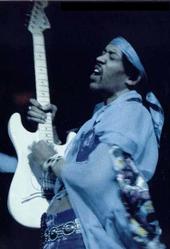Jimi Hendrix (November 27, 1942, Seattle, Washington - September 18, 1970, London, England), born Johnny Allen Hendrix and later renamed James Marshall Hendrix, was a guitarist, singer and songwriter. Hendrix is recognized as one of the greatest and most influential guitarists in rock music history. After initial success in England, he achieved worldwide fame following his 1967 performance at the Monterey Pop Festival. Later, Hendrix headlined the iconic 1969 Woodstock Festival before his death in 1970, at the age of 27.
A self-taught musician, Hendrix played a Fender Stratocaster guitar turned upside down ("left-handed") and restrung to suit him. Hendrix pioneered the technique of guitar feedback with overdriven amplifiers, incorporating what was previously an undesirable sound into his music. He built upon the innovations and influences of blues stylists such as B.B. King, Muddy Waters, Albert King, and T-Bone Walker, and derived style from rhythm and blues and soul guitarists Curtis Mayfield, Steve Cropper, and Cornell Dupree, as well as from traditional jazz. Hendrix's flamboyant stage persona was most likely inspired by rock pioneer Little Richard, with whom he toured as part of Richard's back-up band, "The Upsetters".
Hendrix strove to combine what he called "earth", a blues, jazz, or funk driven rhythm accompaniment, with "space", the high-pitched psychedelic sounds created by his guitar improvisations. As a record producer, Hendrix also broke new ground in using the recording studio as an extension of his musical ideas; he was one of the first to experiment with stereophonic and phasing effects during recording.
Hendrix was inducted into the Rock & Roll Hall of Fame in 1992 and the UK Music Hall of Fame in 2005. His star on the Hollywood Walk of Fame (at 6627 Hollywood Blvd.) was dedicated in 1994. In 2006, his debut album, Are You Experienced, was inducted into the United States National Recording Preservation Board's National Recording Registry. Rolling Stone named Hendrix number one on their list of the "100 greatest guitarists of all time" in 2003 and ranked him #6 in their 100 Greatest Artists of All Time in 2004. He was also ranked number three in VH1's "100 Greatest Hard Rock Artists.
